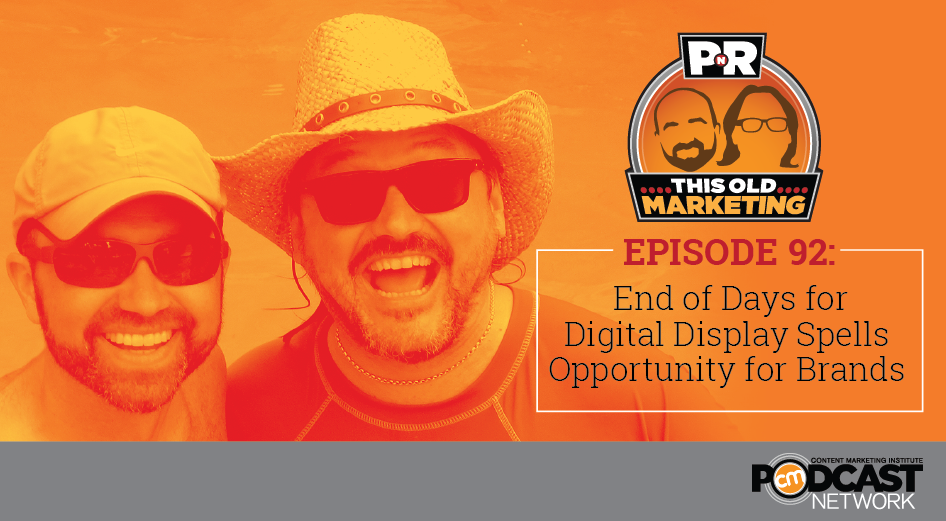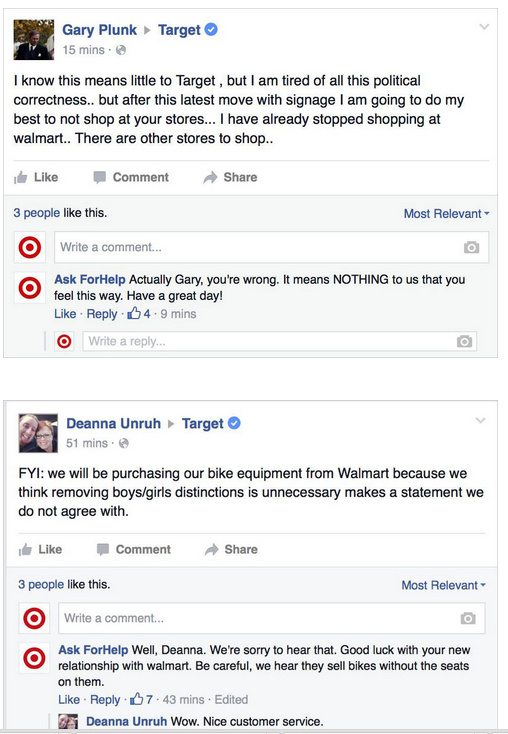
PNR: This Old Marketing with Joe Pulizzi and Robert Rose can be found on both iTunes and Stitcher.
In this week’s episode, Robert and I discuss the “advertising apocalypse” that’s become a critical issue for publishers – and why it’s an opportunity for brands. Next, we ponder the blurring line between journalists and content marketers and agree what should be done about authors who hijack the term “content marketing.” Finally, we lament the ad hoc state of content creation in many organizations today, and encourage marketers to focus on something else that will deliver greater value to their brands and customers. Rants and raves include the secret behind Nike’s YouTube success and Target’s clever response to a customer service troll. We wrap up the show with a #ThisOldMarketing example from Aldus PageMaker.
This week’s show
(Recorded live August 17, 2015; Length: 59:`8)
Download this week’s PNR This Old Marketing podcast.
If you enjoy our PNR podcasts, we would love if you would rate it, or post a review, on iTunes. Missed a previous episode? Go to the main This Old Marketing page for a full list of archives.
1. Content marketing in the news
- Publishers have only themselves to blame for the ad-blocking apocalypse (6:06): According to a study by Adobe Systems and PageFair, the use of ad blocking software has increased 41% in the past year alone, and cost publishers $22 billion in lost revenue. This trend is causing low ad rates, which in turn is forcing publishers to resort to more invasive forms of click-baiting, according to this article on Fortune. I believe this is a non-issue for most niche publishers because they have already diversified away from banner advertising. Robert points out that the article ignores the growth of content, which aims to provide a more engaging experience for the audience, while also meeting the needs of sponsors.
- The journalists who refuse to admit they’re actually content marketers (15:40): Grant Feller, in an opinion column on Forbes, ponders what it means to be a journalist today, and what qualifies as native advertising. In his mind, the lines were blurred between journalism and paid placements long before the digital era began. Unfortunately, it’s clear that Feller doesn’t have an accurate understanding of content marketing. Robert points out that we don’t need to defend every hijacking of the term. Instead, we need to stay the course, focusing on building greater value for businesses.
- Only 2% of marketers have “very effective” content strategy (25:40): Though everyone agrees that “content is king,” only 2% of marketers believe their strategies are highly effective, according to research by the CMO Council. Less than half of the respondents agreed that their strategies are somewhat effective. This article is paired with the next one from the TopRank blog.
- Content marketing inefficiencies cost B2B companies nearly $1 billion (26:22): Not only are companies challenged to create a variety of engaging content on a consistent basis with clear ROI, but the making of content is wasteful as well. A study sponsored by Kapost and conducted by the research firm Gleanster found that inefficiencies in companies’ content marketing efforts are costing U.S. B2B companies nearly $1 billion annually. Robert and I agree that too many brands seem to be focused on creating “snackable” content today. A more valuable approach would be to produce consistent, high-quality content that solves problems for customers.
2. Sponsor (37:13)
- This Old Marketing is sponsored by Emma, email marketing for the modern brand. Emma is a provider of best-in-class software and services that help organizations of all sizes get more from their email marketing. In Emma’s new Modern Marketer’s Field Guide, you’ll learn how to identify (and use) the right marketing tools to craft emails that truly stand out in the inbox and create a personal experience for every subscriber. Download the guide now at http://bit.ly/myemma-field-guide.
3. Rants and raves (40:13)
- Joe’s rave: I love this article from The Observer that explains how Nike has employed a “hero, hub, hygiene” strategy to become the sixth most subscribed and ninth most viewed brand on the platform. Surprisingly, the “hero” content – epic videos that have a lot of free and paid promotion behind them – haven’t been the key to the brand’s growth. Rather, consistency of focus and a commitment to publishing videos on a regular basis is the key to Nike’s success on YouTube. Marketers can learn from its practical, focused approach. This article is a must-read for brand marketers.
- Robert’s rave: In mid-August, Target announced it would phase out gender-specific signage in all of its stores. Predictably, this resulted in a backlash from consumers on social media channels. A Facebook user named Mike Melgaard came to Target’s defense by creating an account named “Ask for Help” and took it upon himself to respond to customer complaints — generally in a highly sarcastic fashion. What surprised Robert is that Target responded with a picture of toy trolls with a message acknowledging Melgaard’s efforts and the sense of humor behind his posts. Well played, Target!

4. This Old Marketing example of the week (50:59)
- Aldus PageMaker: Thirty years ago this month, Aldus PageMaker was launched; it was the very first desktop publishing software program. To commemorate this anniversary, the Huffington Post interviewed CMI contributor Roger Parker, who played a key role in helping it to become a success. Until the launch of this revolutionary program, marketers and agencies relied on typesetters to lay out pages for them. This process was slow, troublesome and expensive. PageMaker revolutionized everything, putting the power of design in the hands of content creators. But Parker saw a problem: Users with no sense of page design were turning out amateurish layouts that threatened to undermine PageMaker’s success. So he approached Aldus with an offer to write a premium book designed to teach non-designers the fundamentals of creating attractive, easy-to-read designs with PageMaker. This free book was given away with the program and was widely distributed by Aldus. The Aldus Guide to Basic Design and a follow-up book, Looking Good in Print, were huge successes, and launched Parker’s career in helping people do graphic design effectively. This book is an excellent example of #ThisOldMarketing.

Can’t get enough of Joe and Robert? Register today for Content Marketing World 2015 this September to catch them in action. Use code CMI100 to save $100.





